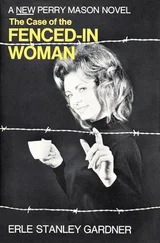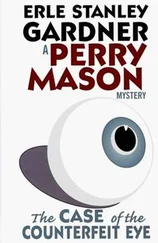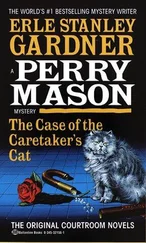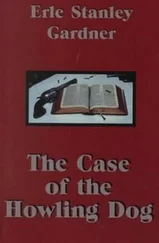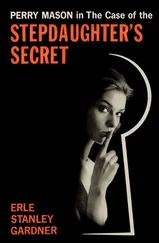The technician centered a bullet marked “test bullet” on one side of the comparison microscope, and the bullet which had been recovered from the cross-section of pile on the other side. He placed his eyes at the eyepieces of the comparison microscope and began slowly turning a knob which rotated one of the bullets. Abruptly he stopped, turned the knob back a fraction of an inch, then raised his fingers to the screw which adjusted the focus of the microscope.
“Well?” Dr. Dixon asked anxiously.
“They’re the same,” the technician said, “fired from the same gun. Take a look.”
Dr. Dixon settled himself on the stool vacated by the technician, applied his eyes to the microscope, studied the two bullets carefully. “That does it,” he said. “We’ve had to stretch our jurisdiction to get the evidence, but this is it. They were both fired from the same gun.”
“Where does that leave us?” the technician asked.
There was the ghost of a twinkle in Dr. Dixon’s eyes. “That leaves us with three bullets and two empty cartridge cases.”
“Then we’re short one cartridge case.”
“On the contrary,” Dr. Dixon said, “we’re long one bullet.”
The preliminary hearing of Robert Trenton for the murder of Harvey Richmond was very much of a cut-and-dried procedure so far as the People’s case was concerned.
Having proven the identity of the charred corpse by a chart of the teeth and the testimony of a dentist, Norton Berkeley, the prosecutor, called Dr. Nathan Beaumont to the stand.
Dr. Beaumont, crisply professional, testified that he had been called to the burned houseboat, that he had been shown the charred remains of the deceased by the sheriff; that he had at first decided death was from burning, but in order to make certain, had taken X-ray photographs of the charred body. These X-ray photographs had disclosed the presence of two bullets. He had, therefore, carefully probed for and located the bullets. From their position in the body, he would say that one of them had completely perforated the heart, the other had been immediately above the heart, puncturing a large blood vessel. In the doctor’s opinion, either bullet would have been instantly fatal.
The doctor testified that he had marked these bullets so he could identify them, and had delivered them to the coroner. The two bullets, which he now produced to be introduced in evidence, were the same bullets he had taken from the charred body. He would give it as his opinion that death was produced by gunshot wounds, that in fact he would go further and state death was caused by the two bullets he had produced.
On cross-examination, Staunton Irvine, the attorney representing Rob Trenton, having studied the list of questions which Dr. Dixon had told Trenton to deliver to his attorney, launched a somewhat half-hearted cross-examination.
“Had the investigation stopped when the bullets were found?”
Dr. Beaumont fixed the attorney with a scornful eye and said patronizingly, “I was employed to find the cause of death. I found the cause of death.”
“And then you ceased to investigate, Doctor?”
“Having found that for which I was searching, I ceased searching — which is a natural thing to do.”
“Was there evidence of hemorrhage in the vicinity of the bullets?”
“There was. That is, there was as much evidence as you could expect. The body had been charred, literally cooked.”
“You’re certain that these bullets were the cause of death?”
“As certain as I am that I’m sitting here.”
Dr. Beaumont impatiently glanced at his wristwatch.
“That’s all,” Irvine said.
The doctor was excused. The next witness was a ballistic expert who introduced the .32 automatic into evidence, produced a test bullet which had been fired from it and identified the two bullets as having been fired from that particular .32 automatic.
“Call Merton Ostrander,” the district attorney said.
Merton Ostrander arose and said, “I feel that I can contribute nothing and...”
“Come forward and be sworn,” the district attorney said.
“I prefer not to.”
“Your preferences have nothing whatever to do with it,” the judge said. “Come forward, young man, hold up your right hand and be sworn.”
Ostrander hesitated, then, with quite obvious reluctance, walked down the aisle, opened the swinging gate in the bar which separated the litigants, witnesses and attorneys from the others, and advanced towards the witness-stand, where he was sworn.
“Sit right down there,” the judge said..
“Now then,” District Attorney Berkeley said in a loud, dramatic voice, “I have here, Your Honor, a hostile witness. It’s going to be necessary to ask him some leading questions. He is testifying with obvious reluctance and...”
“Go ahead,” the judge said. “I will be able to see the attitude of the witness without having someone point it out to me.”
The district attorney said, “Mr. Ostrander, I’ll call your attention to the night of the twentieth. Did you know the defendant at that time?”
“I did. Yes, sir.”
“Did you see the defendant on that night?”
“Yes, sir.”
“Did he have some weapon with him?”
Ostrander hesitated.
“Answer the question,” snapped the district attorney.
“Yes, sir, he did.”
“Have you ever seen this .32 automatic before?” the district attorney asked, and then added, “Let the record show that I am handing the witness People’s exhibit number three.”
“I... I believe I have.”
“Don’t you know?”
“Yes.”
“Have you?”
“Yes.”
“Where?”
“I saw it late on the evening of the twentieth, or rather earlier, on the morning of the twenty-first.”
“At about what time?”
“Around two o’clock in the morning.”
“And who had that weapon?”
Ostrander changed position.
“Mr. Ostrander, I asked you a question. Who had that weapon?”
“Robert Trenton.”
“The defendant?”
“Yes, sir.”
“Did he make any statement in connection with it?”
“He said that he had been held a captive and had made his escape, and that he had taken this weapon with him to protect himself.”
“And did he say anything about having shot it?”
“Yes. He said he had fired it.”
“How many times?”
“Twice.”
“At what?”
“At... well, in order to force someone on the houseboat to keep his distance; to keep that person from coming ashore.”
“And where was it this conversation took place?”
“At the home of Linda Mae Carroll.”
“What’s the address?”
“205 East Robinson Street, Falthaven.”
“Who was present?”
“Linda Mae Carroll, her niece Linda Carroll, Robert Trenton and I.”
“Anyone else?”
“No one else.”
“How did it happen that you were there, Mr. Ostrander?”
“I had been in contact with Miss Linda Carroll earlier in the day. I decided to try and locate her at the residence of her aunt, Linda Mae Carroll. At that time it was quite late in the evening and...”
“How late?”
“Well, I would say it was around eleven o’clock or eleven-thirty, perhaps a little later.”
“Very well, go on. What happened?”
“And Linda Mae Carroll, that’s Miss Carroll’s aunt, had retired for the night. She got up, however, and very graciously insisted that I stay all night, when it later appeared I’d missed the bus.”
“Cross-examine,” the district attorney said.
Staunton Irvine said belligerently, “How do you know this is the same weapon that you saw?”
“There was a question about notifying the police,” Ostrander said, “and after some discussion it was decided to wait until morning, and go back to the place where the... well, where the trouble had occurred, and look around a bit.”
Читать дальше


